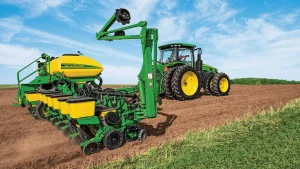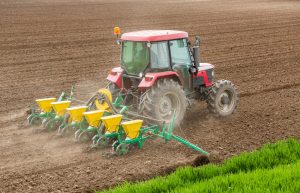Welcome to the future of farming where precision meets innovation. Advanced agricultural technology for precise seed placement is revolutionizing the way farmers cultivate crops, bringing forth a new era of efficiency, sustainability, and increased yields. In this article, we will delve into the various facets of this cutting-edge technology, exploring its components, benefits, challenges, and the transformative impact it has on agriculture globally.
traditionally, planting has been a game of chance, a scatter-shot approach hoping for fertile ground. But in the face of a growing population and increasingly limited resources, modern agriculture demands a new level of control: precision seed placement. This article explores the transformative power of advanced technology in redefining how we plant, ushering in a future of maximized efficiency, optimized yields, and sustainable practices.
The Challenges of Old Methods: Imagine throwing garbanzos across a field and hoping they sprout into a flourishing garden. That’s essentially the gamble of traditional sowing methods. Uneven distribution, wasted seeds, and suboptimal planting depths hamper yields and contribute to environmental concerns. The need for a more scientific approach becomes evident.
Enter Precision Agriculture: This revolutionary discipline leverages technology to transform farming from guesswork to informed action. GPS, robotics, sensors, and data analysis work together to create a symphony of precision, dictating where each seed finds its perfect home in the soil.
GPS Takes the Wheel: Think of GPS as a map-guided maestro, directing planting equipment with pinpoint accuracy. Farmers can create digital field maps, factoring in soil variations and topographical features. Then, GPS-guided tractors navigate rows with laser-like precision, ensuring seeds are placed at the desired depth and spacing.
Variable Rate Technology (VRT): Imagine treating your field like a mosaic, adapting to each tile’s unique needs. VRT utilizes soil maps and real-time sensors to analyze nutrients, moisture, and other factors. Based on this data, it automatically adjusts seed application rates, ensuring each zone receives the optimal amount for maximum growth.
Hands-Free Steering: Ditch the manual steering wheel and let robots take the reins. Auto-steer systems utilize GPS and onboard sensors to guide equipment with unwavering accuracy, minimizing overlap and ensuring perfectly straight rows. Imagine a field etched with laser precision, a testament to the power of automation.
Saving Every Seed: Picture a meticulous accountant, keeping tabs on every resource. Section control technology uses GPS and sensors to identify areas already planted and automatically shuts off seed delivery accordingly. This eliminates overplanting, saving seeds, and ensuring efficient resource utilization.
High-Tech Tools of the Trade: Modern planting equipment is no longer just metal and gears. Advanced planters boast row shut-off systems that react to real-time data, stopping seed dispensing in areas with obstacles or already planted sections. This not only optimizes seed usage but also protects equipment from damage.
Sensor Symphony: Picture the field as a whisperer, constantly sharing its secrets. High-resolution sensors collect data on everything from soil moisture to nutrient levels in real time. This constant stream of information feeds into the decision-making process, allowing farmers to fine-tune planting parameters for optimal results.
Birds-Eye View from Above: Enter the age of flying field assistants. Drones equipped with advanced sensors soar above the crops, capturing high-resolution imagery and generating detailed maps. This aerial data provides invaluable insights into field health, enabling farmers to make strategic decisions about seed placement and resource allocation from the comfort of their control room.
Data-Driven Decisions: Imagine farming by numbers, not hunches. Farm management software analyzes vast amounts of data from sensors, drones, and GPS systems, uncovering hidden patterns and offering tailored recommendations. This allows farmers to make informed decisions about everything from seed selection to planting depth, maximizing efficiency and yield.
Diving Deeper: Not all soil is created equal. Variable depth planting acknowledges this diversity, adjusting planting depth based on specific field conditions. This ensures seeds reach the ideal germination zone, regardless of soil type or topography, leading to higher germination rates and more uniform growth.
Real-Time Control at Your Fingertips: Precision doesn’t end when the seed hits the ground. Modern equipment lets farmers monitor planting operations in real time from their tablets or smartphones. They can adjust settings, troubleshoot issues, and optimize performance on the fly, ensuring every step of the planting process is under their control.
Reaping the Rewards: The benefits of precise seed placement are numerous. Increased efficiency minimizes seed waste and fuel consumption, reducing costs and environmental impact. Optimized planting leads to higher yields, enhanced crop quality, and increased profitability. Ultimately, precision agriculture allows farmers to produce more food with fewer resources, paving the way for a more sustainable future.
Conclusion: As we stand at the crossroads of tradition and innovation, the seed drill transforms from a simple tool into a symbol of agricultural evolution. It embodies the future of farming, where science and technology dance with the rhythms of nature, orchestrating symphonies of abundance. Embracing these advancements holds the key to unlocking a bountiful harvest, not just for the present, but for generations to come.
FAQs
Is advanced agricultural technology affordable for small-scale farmers?
Yes, advancements in technology have led to more affordable options, making it accessible to small-scale farmers. Government initiatives and subsidies further support affordability.
How does precision farming contribute to environmental sustainability?
Precision farming minimizes resource wastage, optimizes input usage, and reduces the environmental impact of agriculture, promoting sustainability.
Are there risks associated with relying on technology for farming decisions?
While technology offers immense benefits, farmers must be aware of potential risks such as system failures, cyber threats, and the need for continuous updates.
Can advanced agricultural technology be customized for different crops?
Yes, the adaptability of advanced agricultural technology allows for customization based on the specific needs and requirements of different crops.
What role does data privacy play in the adoption of agricultural technology?
Ensuring data privacy is crucial in the adoption of agricultural technology. Farmers must be informed about how their data is collected, stored, and used.
How can farmers stay updated on the latest advancements in agricultural technology?
Farmers can stay updated through agricultural extension services, workshops, and collaboration with technology providers. Continuous learning is key.
Conclusion
In conclusion, advanced agricultural technology for precise seed placement heralds a new era in farming, promoting efficiency, sustainability, and increased yields. Embracing this technology requires a careful consideration of benefits, challenges, and the evolving landscape of agricultural practices. As we move towards a more connected and technologically advanced future, the role of farmers as stewards of the land remains paramount.




